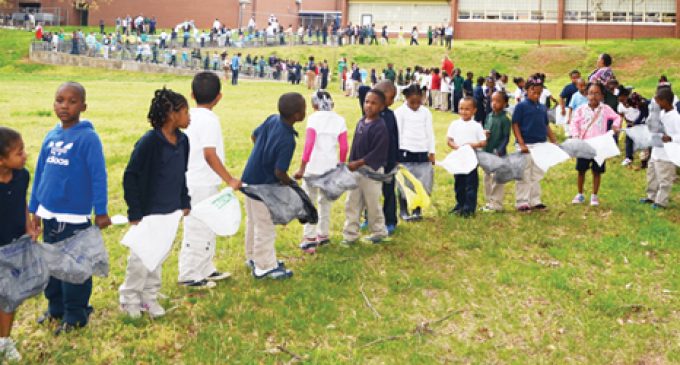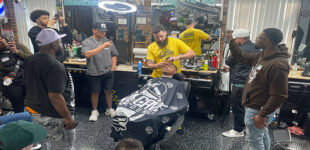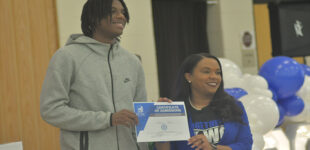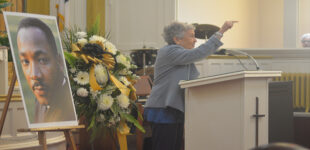It’s In the Bag

Project pushes students to eschew environmentally-toxic plastic shopping bags
(pictured above: Hundreds of students take part in the Earth Day demonstration.)
To celebrate Earth Day, Cook Elementary School students showed – in dramatic fashion – the negative environmental impacts of a widely-used product – the plastic shopping bags.
Hundreds of plastic bag-carrying students circled the grassy field behind the school on Tuesday, April 22; together, they buttressed a chain made of more than 1,000 plastic shopping bags; that’s the equivalent of what one American couple might use over the course of a year, according to Angela Claudio, a Cook teacher who organized the program.
Claudio wanted to show students the impact one or two people can have on the environment and offer solutions on how everyone can become a better global citizen.
“It’s my passion for us to be able to learn about recycling because a lot of times, our socio-economic status impacts how we treat the environment, and it shouldn’t be that way,” she declared. “I feel like our students have the power and the ability to make an impact.”
Prior to the formation of the plastic bag chain, Claudio led a brief assembly during which she asked the students and staff to commit to using reusable canvas shopping bags whenever possible instead of the non-biodegradable plastic ones used by most grocery and retail stores. Two of Claudio’s students modeled plastic bag dresses to illustrate the ugliness of pollution.
“Would you want to walk around like that?” Claudio asked, receiving a chorus of “No!” from her enthusiastic audience. “Well, neither do our animals … we don’t want to continue to pollute our earth. We want to protect the natural resources that we have, and guess who can make that change? You can make that change.”
Khadija Evans and her class of animated kindergardeners led the plastic bag chain demonstration, carrying the initial strands onto the field. Evans said she and her students had been discussing preservation and the importance of protecting the environment in anticipation of Earth Day. In addition to touting eco-friendliness, Evans said the project had peripheral benfits.
“I think it’s a good idea because it shows teamwork and cooperation,” she said.
Although they are young, Evans says her students grasp the importance of preservation. The youngsters were eager to prove their teacher right, shouting answers to her questions about the environment.
“Is water man made or natural?” Evans prompted.
“Natural!” the students chirped.
“It comes from rain,” explained Dre’Quan Wilson.
“If you drink dirty water, you will get sick,” his friend Kennard Oglesby added earnestly.
“We’ve been talking about our impact on the environment, and how just cleaning up and taking care of that one piece of paper or trash means a lot to people and animals,” said Evans, who has spent over two decades in the classroom.
Principal Chris Massenburg praised the project, which was modeled after an initiative Claudio found online, for its ingenuity in delivering what he sees as a very important message to the roughly 275 students who attend Cook.
“I am green at heart, so any opportunity we get to teach our children coming up to have that green mentality about recycling and preserving our habitat, I’m all for it,” he declared. “…We want everybody – starting with our youngest – to learn how to take care of our environment.”
When all the students were assembled in a circle, Claudio made one more plea for them to be mindful of their impact on the environment, and the world.
“Boys and girls, look at the circle,” she said, gesturing to the vast expanse of plastic. “We can make a difference.”






















